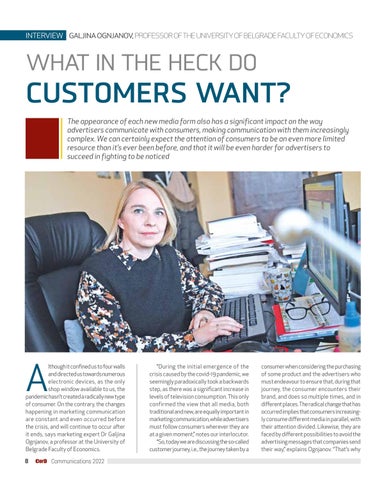INTERVIEW GALJINA OGNJANOV, PROFESSOR OF THE UNIVERSITY OF BELGRADE FACULTY OF ECONOMICS
WHAT IN THE HECK DO
CUSTOMERS WANT? The appearance of each new media form also has a significant impact on the way advertisers communicate with consumers, making communication with them increasingly complex. We can certainly expect the attention of consumers to be an even more limited resource than it’s ever been before, and that it will be even harder for advertisers to succeed in fighting to be noticed
A
lthough it confined us to four walls and directed us towards numerous electronic devices, as the only shop window available to us, the pandemic hasn’t created a radically new type of consumer. On the contrary, the changes happening in marketing communication are constant and even occurred before the crisis, and will continue to occur after it ends, says marketing expert Dr Galjina Ognjanov, a professor at the University of Belgrade Faculty of Economics.
8
Communications 2022
“During the initial emergence of the crisis caused by the covid-19 pandemic, we seemingly paradoxically took a backwards step, as there was a significant increase in levels of television consumption. This only confirmed the view that all media, both traditional and new, are equally important in marketing communication, while advertisers must follow consumers wherever they are at a given moment,” notes our interlocutor. “So, today we are discussing the so-called customer journey, i.e., the journey taken by a
consumer when considering the purchasing of some product and the advertisers who must endeavour to ensure that, during that journey, the consumer encounters their brand, and does so multiple times, and in different places. The radical change that has occurred implies that consumers increasingly consume different media in parallel, with their attention divided. Likewise, they are faced by different possibilities to avoid the advertising messages that companies send their way,” explains Ognjanov. “That’s why
















